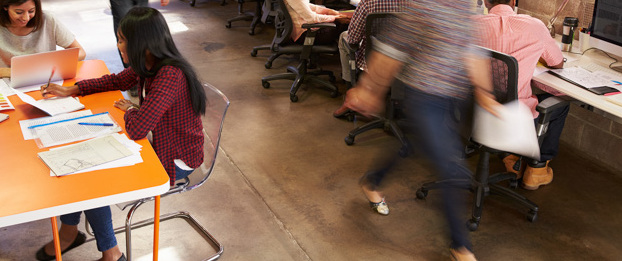Office Design Evolution: Creating a Space That Promotes Productivity

This article was updated on July 27, 2018.
When you're working to maximize productivity and encourage innovation, an office design evolution may not immediately come to mind. But it should be one of the first areas you evaluate. If people are uncomfortable in their work environment, it can show up in their performance. Innovative office design can inspire employees, foster collaboration and enhance productivity.
The History of Office Design Trends
The layout of office space has influenced worker productivity since the early 1900s. It's a model that's been continually developed in ongoing attempts to create the most productive environment possible. Approaches to achieving this goal are still evolving. Societal values and workplace behaviors have also impacted how spaces are designed.
The Factory
The first office spaces were designed by American engineer Frederick Taylor, according to ToolsHero. Inspired by manufacturing firms, workers were placed in open floor plans while management looked on from an office above.
The Landscape
Also referred to as Bürolandschaft, this type of design was dreamed up by two German brothers in 1958, according to The Washington Post. This was the first introduction of a truly open floor plan concept.
The Cubicle
After the open floor plan of the 60s, many organizations sought some degree of privacy. "Cubes" were erected, consisting of four walls that could easily be dismantled and reassembled.
The Open Plan
With the proliferation of wireless technology and telecommuters, this design is intended to be more comfortable and exciting and help create connections for those workers who aren't in the office each day. Pool tables, snack bars and bean bags are common. According to Gensler, workers who choose their own workspace are more satisfied and productive than those who work in the same space.
Current Office Design Trends
Current trends in office design are taking a more holistic approach in an attempt to cater to and attract workers in today's more socially conscious workforce.
Biophilia
Biophilia design is based on the concept that surrounding humans with plant life breeds well-being, according to Terrapin Bright Green. This concept helps connect workers with nature when they're stuck inside for long periods of time.
Social Spaces
These offices are built on the concept that innovation comes from spontaneous collaboration. Facebook designed an office specifically intended for mingling, and CEO Mark Zuckerberg's desk is right in the middle, according to CNBC. The concept behind these types of designs is that creativity comes from discussions, not monitors.
Office Design and Productivity
Design has yet to reach peak productivity enhancement. According to Gallup, worker engagement is only at 32 percent. The future of office design includes trends in spaces with programmable habits. Rooms can actually create metrics on worker productivity, and the spaces can be adjusted accordingly.
HR leaders and organizations should begin to think about ways to measure whether a certain design is affecting employee performance, and how to optimize it with the use of space, technology and other factors. Sociometric badges can capture communication and interaction within an office space and report back, revealing data about productivity.
Although there's still much to be done in terms of office design evolution, we've come a long way since the days of a cold factory floor.



